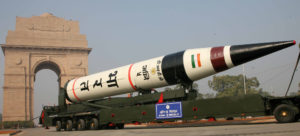Indian Defense Budget – Tricked into debt?
India’s trend in defence expenditure showcases a declining pattern in growth due to increase in revenue expenditure while capital expenditure consisting armaments, technology and other equipments lag behind.
R
 ecent Stockholm International Peace Research Institute (SIPRI) reports on military expenditure complements a previous similar report published by International Institute for Strategic Studies (IISS) confirming that India is the 5th largest spender on military leaving behind countries like the UK and Australia. This is evident for the fact that India is doing much to secure its borders and have a modern military. This was confirmed by the Union Finance Minister while presenting the Union Budget for the year 2018-2019 to the Parliament, where he said, “emphasis has been given to modernizing and enhancing the operational capability of the Defence Forces.”
ecent Stockholm International Peace Research Institute (SIPRI) reports on military expenditure complements a previous similar report published by International Institute for Strategic Studies (IISS) confirming that India is the 5th largest spender on military leaving behind countries like the UK and Australia. This is evident for the fact that India is doing much to secure its borders and have a modern military. This was confirmed by the Union Finance Minister while presenting the Union Budget for the year 2018-2019 to the Parliament, where he said, “emphasis has been given to modernizing and enhancing the operational capability of the Defence Forces.”
According to the Budget 2018-19, the total defense allocation amounts to Rs. 2,79,305 crore. Out of which the Revenue expenditure amounts to Rs. 1,85,323 crores which is 8.83 per cent more than the previous year’s revised estimates, while the capital expenditure is Rs. 93,982 crores which is 8.66 per cent more than last year’s estimates. The government has also opened up the scope for private investment in defence production which also consists liberalization of foreign direct investment. Also, government proposes the development of two defence industrial production corridors in the country and is set to bring an “industry friendly Defence Production Policy 2018” to encourage public and private sector as well as MSMEs towards increasing domestic production. Moreover, the Government has approved road construction on the Sela Pass that connects Tawang region (one of the disputed regions with China) of Ladakh to the rest of the country, in addition to other construction undertaken by the Border Roads Development Board and Coast Guard organisation.
The trend in expenditure shows a declining pattern in growth due to increase in revenue expenditure such as increases in salaries and pensions of the armed forces as compared to capital expenditure which consists of armaments, technology and other equipments.
In India’s case, Bharat Karnad, Research Professor in National Security Studies at the Centre for Policy Research, comments on revenue expenditure as, “Other than the downstream social benefits of military salaries and pensions of a manpower-wise huge military that swallow a large part of the country’s expenditure on defence and impact even the remote areas of the country, the objective of national security is ill-served.”
 Moreover, spending on the Indian Army accounts for over 85 per cent of the total outlay. Comparatively, the figures for the Air Force and Navy are 58 per cent and 51 per cent respectively. Whereas Capital Outlays make up 33 per cent of total defense spending, research and development have fallen by 0.9 per cent compared to the previous year. While the R&D for the Air Force saw a positive change in its budgetary estimates by 12.1 per cent, the statistics for the Army and Navy show a decline by 6.4 per cent and 12.1 per cent respectively.
Moreover, spending on the Indian Army accounts for over 85 per cent of the total outlay. Comparatively, the figures for the Air Force and Navy are 58 per cent and 51 per cent respectively. Whereas Capital Outlays make up 33 per cent of total defense spending, research and development have fallen by 0.9 per cent compared to the previous year. While the R&D for the Air Force saw a positive change in its budgetary estimates by 12.1 per cent, the statistics for the Army and Navy show a decline by 6.4 per cent and 12.1 per cent respectively.
Since revenue expenditure does not create any assets or reduces any liabilities and therefore cannot be used as an indicator for growth. While capital expenditure leads to creation of assets such as purchase or investment in new machinery and technology. It adds to the capital stock of the economy and can be considered as the indicator of actual growth.
Bharat Karnad also adds, “Whatever its intention, the government fuels and perpetuates the import dependency of the armed services rather than insisting that the Indian military forego arms imports, become stakeholders in indigenous defence industry and ensure that the defence capital budget in 2018-19 of Rs 93,982 crores is spent within the country on defence procurement. Because there are no restrictions on the Indian military’s buying its requirements from abroad the defence capital budget ends up mostly benefiting foreign vendors. Meanwhile, the Indian industry remains in the doldrums and the scale of employment that can be generated by the Indian defence industry in both the private and public sector working at full tilt remains unrealized.”
According to the recent fact sheet on Trends in Military Expenditure 2017 published by SIPRI, India is reported to be the Fifth largest spender on military and the second largest in the Asia and Oceania region. However, the key question remains, does this position indicate growth as compared to other states in the top 5 list? When the United States, China or Russia is concerned, the report states that the increased spending directly corresponds to an increased support given to military personnel coupled with modernisation of their armaments. An important factor to borne while considering the military expenditure for these states is that their capital expenditure indicates actual growth wherein, all defense related production is mostly domestic production in combination with high export rates.
Such expenditure boosts their economy and reflects actual growth which is unlike India’s case, whereby, the capital expenditure usually is used up to pay debts and high levels imports from foreign industry such that Indian economy is drained to such a great extent just to maintain a decent levels of armaments, machinery and technology.
